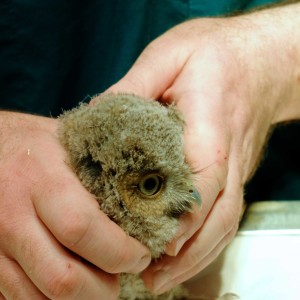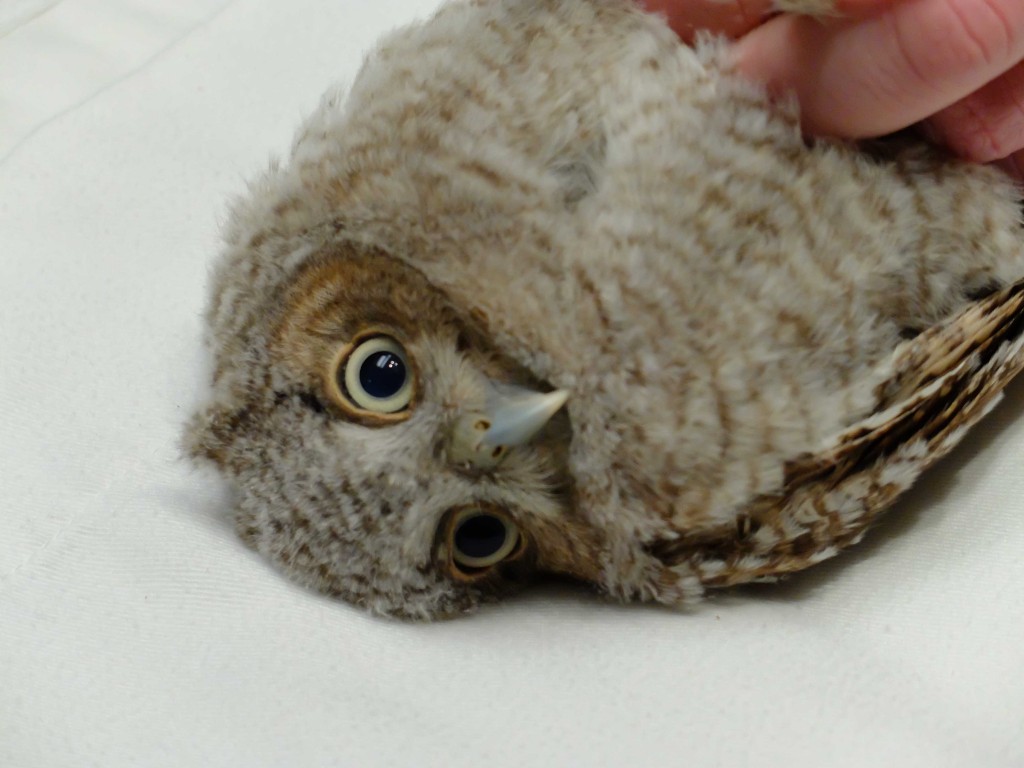By Mike Weilbacher, Executive Director
On Monday, May 16, Cecily Tynan, meteorologist at 6ABC’s Action News, was running in Tyler Arboretum when she discovered a young screech owl on the ground, “squawking,” as she called it in a video she posted to Facebook (seen by 80,000 people as of this afternooon), and, clacking its beak at her.
She called the Wildlife Clinic at the Schuylkill Center, listened to the phone machine’s instructions, and smartly threw her outer garment over the owl’s head to calm it down, which is exactly what to do—and brought it to us in a box.
It was promptly assigned case number 0965, the 965th animal brought to the clinic so far this year—we get about 3,300 annually.
 Luckily, its wings were not broken, but it had fallen out of its nest, usually a cavity in a tree, and was severely dehydrated—likely without a mother, it presumably had not eaten in a while, as its food is where it gets its water.
Luckily, its wings were not broken, but it had fallen out of its nest, usually a cavity in a tree, and was severely dehydrated—likely without a mother, it presumably had not eaten in a while, as its food is where it gets its water.
The owl, named Ridley by Cecily, is about a month old, thinks Rick Schubert, the clinic’s director. It’s still a nestling, not yet having its wing feathers grown in enough to learn to fly.
Later that same day, another screech owl of about the same age was coincidentally brought to the clinic, and the two are now hanging out, going through their rehab together. Rick is giving Ridley fluids hoping to rehydrate nestling, and started feeding it solid food today. With luck and care, Ridley should be able to hunt and fly this summer, meaning it can be released in August.
The screech owl is one of the smallest and most common of local owls, compact in size, and named for its call, a long horse-like whinny. (The classic “who, who” song of owls is the vocalization of the great horned owl, its much larger, much bigger clawed cousin.) The beak-clacking Cecily videotaped is one of its defense mechanisms; another is squinting to hide its large eyes, relying on its feather coloration to blend in with tree bark: when a screech owl is sitting against the trunk of a tree, it is surprisingly hard to see. Even better, screech owls will stretch their bodies and lean to one side—making them appear to be braches sticking out of the trunk.
These owls are nocturnal hunters, screech owls eating a wide variety of prey—small mice, squirrels, birds, even insects and crayfish. While screech owls are solitary, during the winter breeding season males build nests to attract females. Females select mates based on the quality of the nest and the food located inside. While incubating the eggs, the male feeds the female.
So while it is unclear what happened Case #0956’s parents or siblings, it is clear that this one would not have survived much longer, lethargic, dehydrated, and very vulnerable to a wide variety of predators while on the ground.
It is a good thing Cecily brought it to us when she did, and we hope it meets all the marks it needs to be released in August.
We’ll keep you posted.
May 18, 2016 ETA: Correction above, the screech of is not the smallest local owl, that would be the saw-whet owl.


Thank you for taking the time to post update–and for such thorough info
A beautiful bird. I am a bird carver and have carved both the Saw whet and Screech owl. The saw whet is the smallest for sure.